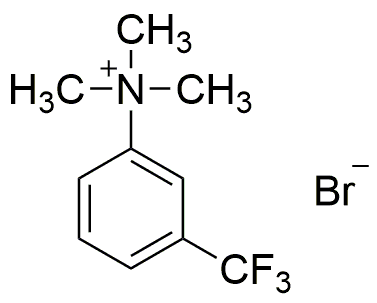3-(Trifluoromethyl)phenyltrimethylammonium bromide is widely utilized in research focused on:
- Organic Synthesis: This compound serves as a versatile reagent in organic chemistry, particularly in the synthesis of complex molecules, allowing researchers to create new compounds with specific properties.
- Pharmaceutical Development: It is employed in drug formulation processes, enhancing the solubility and bioavailability of active pharmaceutical ingredients, which is crucial for effective medication delivery.
- Material Science: The compound is used in the development of advanced materials, including polymers and coatings, that require specific chemical properties for improved performance in various applications.
- Biochemical Research: It acts as a quaternary ammonium salt, making it useful in studying membrane interactions and cellular processes, which can lead to insights in cell biology and pharmacology.
- Environmental Chemistry: This chemical is involved in the study of environmental pollutants, helping researchers understand their behavior and effects, which is vital for developing remediation strategies.
General Information
Properties
Safety and Regulations
Applications
3-(Trifluoromethyl)phenyltrimethylammonium bromide is widely utilized in research focused on:
- Organic Synthesis: This compound serves as a versatile reagent in organic chemistry, particularly in the synthesis of complex molecules, allowing researchers to create new compounds with specific properties.
- Pharmaceutical Development: It is employed in drug formulation processes, enhancing the solubility and bioavailability of active pharmaceutical ingredients, which is crucial for effective medication delivery.
- Material Science: The compound is used in the development of advanced materials, including polymers and coatings, that require specific chemical properties for improved performance in various applications.
- Biochemical Research: It acts as a quaternary ammonium salt, making it useful in studying membrane interactions and cellular processes, which can lead to insights in cell biology and pharmacology.
- Environmental Chemistry: This chemical is involved in the study of environmental pollutants, helping researchers understand their behavior and effects, which is vital for developing remediation strategies.
Documents
Safety Data Sheets (SDS)
The SDS provides comprehensive safety information on handling, storage, and disposal of the product.
Product Specification (PS)
The PS provides a comprehensive breakdown of the product’s properties, including chemical composition, physical state, purity, and storage requirements. It also details acceptable quality ranges and the product's intended applications.
Certificates of Analysis (COA)
Search for Certificates of Analysis (COA) by entering the products Lot Number. Lot and Batch Numbers can be found on a product’s label following the words ‘Lot’ or ‘Batch’.
*Catalog Number
*Lot Number
Certificates Of Origin (COO)
This COO confirms the country where the product was manufactured, and also details the materials and components used in it and whether it is derived from natural, synthetic, or other specific sources. This certificate may be required for customs, trade, and regulatory compliance.
*Catalog Number
*Lot Number
Safety Data Sheets (SDS)
The SDS provides comprehensive safety information on handling, storage, and disposal of the product.
DownloadProduct Specification (PS)
The PS provides a comprehensive breakdown of the product’s properties, including chemical composition, physical state, purity, and storage requirements. It also details acceptable quality ranges and the product's intended applications.
DownloadCertificates of Analysis (COA)
Search for Certificates of Analysis (COA) by entering the products Lot Number. Lot and Batch Numbers can be found on a product’s label following the words ‘Lot’ or ‘Batch’.
*Catalog Number
*Lot Number
Certificates Of Origin (COO)
This COO confirms the country where the product was manufactured, and also details the materials and components used in it and whether it is derived from natural, synthetic, or other specific sources. This certificate may be required for customs, trade, and regulatory compliance.


